Leadership and Change Management: Healthcare Organization Analysis
VerifiedAdded on 2021/04/24
|16
|4942
|20
Essay
AI Summary
This essay explores the critical roles of leadership and change management within a healthcare organization, focusing on addressing the issue of obesity. It examines various leadership styles, including democratic, autocratic, transactional, transformational, and others, evaluating their suitability for the healthcare sector. The essay emphasizes the adoption of transformational leadership to inspire positive changes within the organization and the community. It highlights the importance of motivating employees to embrace change and promoting awareness about the health implications of obesity. The analysis underscores the impact of leadership in delivering effective healthcare services and the need for strategic change management to improve societal well-being. The essay concludes by advocating for systematic changes in the medical field to combat obesity and improve overall health outcomes. This assignment, contributed by a student, is available on Desklib, a platform providing AI-based study tools.

Running head: LEADERSHIP AND MANAGEMENT
Leadership and Management
Name of Student
Name of University
Author Note
Leadership and Management
Name of Student
Name of University
Author Note
Paraphrase This Document
Need a fresh take? Get an instant paraphrase of this document with our AI Paraphraser
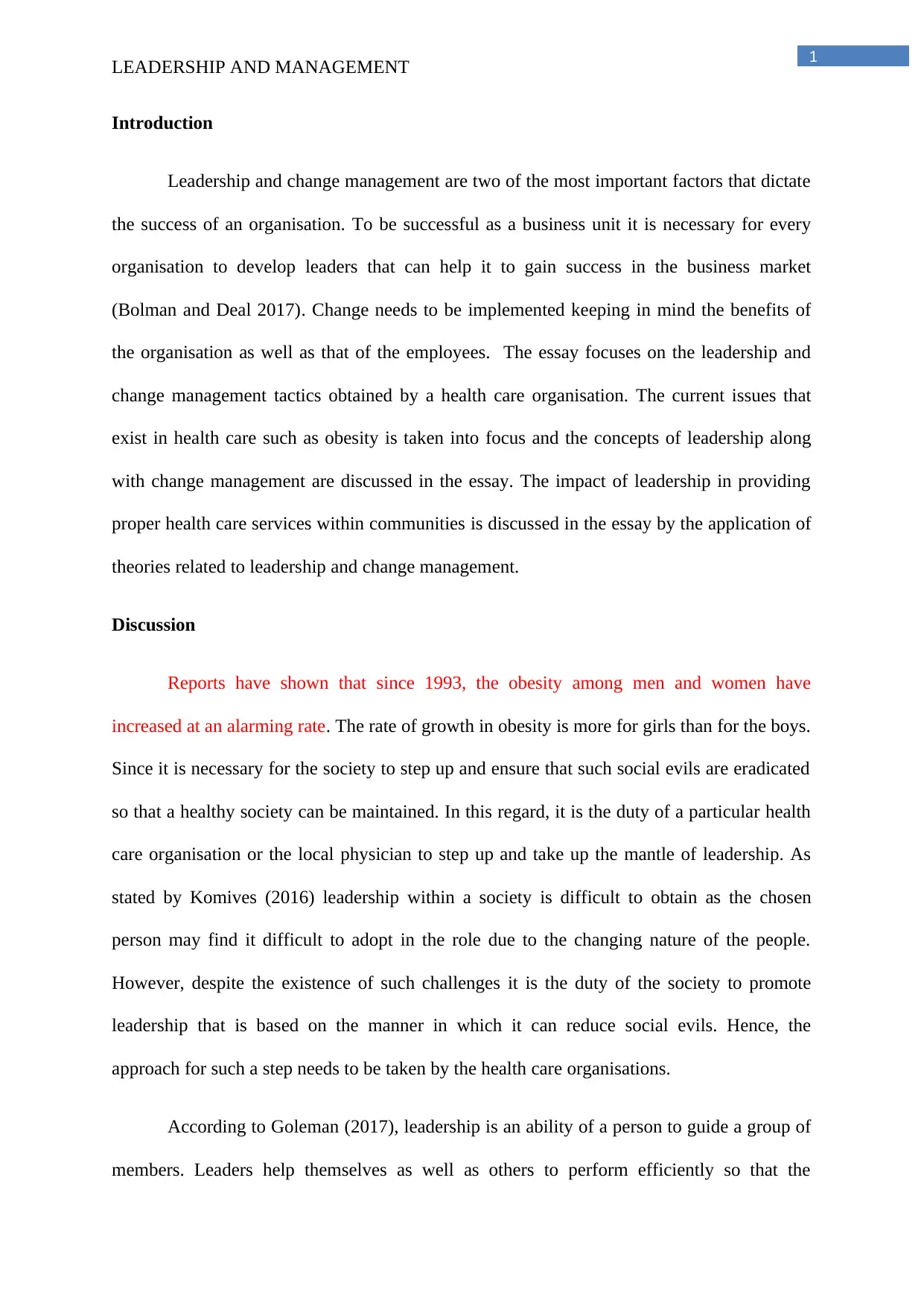
1
LEADERSHIP AND MANAGEMENT
Introduction
Leadership and change management are two of the most important factors that dictate
the success of an organisation. To be successful as a business unit it is necessary for every
organisation to develop leaders that can help it to gain success in the business market
(Bolman and Deal 2017). Change needs to be implemented keeping in mind the benefits of
the organisation as well as that of the employees. The essay focuses on the leadership and
change management tactics obtained by a health care organisation. The current issues that
exist in health care such as obesity is taken into focus and the concepts of leadership along
with change management are discussed in the essay. The impact of leadership in providing
proper health care services within communities is discussed in the essay by the application of
theories related to leadership and change management.
Discussion
Reports have shown that since 1993, the obesity among men and women have
increased at an alarming rate. The rate of growth in obesity is more for girls than for the boys.
Since it is necessary for the society to step up and ensure that such social evils are eradicated
so that a healthy society can be maintained. In this regard, it is the duty of a particular health
care organisation or the local physician to step up and take up the mantle of leadership. As
stated by Komives (2016) leadership within a society is difficult to obtain as the chosen
person may find it difficult to adopt in the role due to the changing nature of the people.
However, despite the existence of such challenges it is the duty of the society to promote
leadership that is based on the manner in which it can reduce social evils. Hence, the
approach for such a step needs to be taken by the health care organisations.
According to Goleman (2017), leadership is an ability of a person to guide a group of
members. Leaders help themselves as well as others to perform efficiently so that the
LEADERSHIP AND MANAGEMENT
Introduction
Leadership and change management are two of the most important factors that dictate
the success of an organisation. To be successful as a business unit it is necessary for every
organisation to develop leaders that can help it to gain success in the business market
(Bolman and Deal 2017). Change needs to be implemented keeping in mind the benefits of
the organisation as well as that of the employees. The essay focuses on the leadership and
change management tactics obtained by a health care organisation. The current issues that
exist in health care such as obesity is taken into focus and the concepts of leadership along
with change management are discussed in the essay. The impact of leadership in providing
proper health care services within communities is discussed in the essay by the application of
theories related to leadership and change management.
Discussion
Reports have shown that since 1993, the obesity among men and women have
increased at an alarming rate. The rate of growth in obesity is more for girls than for the boys.
Since it is necessary for the society to step up and ensure that such social evils are eradicated
so that a healthy society can be maintained. In this regard, it is the duty of a particular health
care organisation or the local physician to step up and take up the mantle of leadership. As
stated by Komives (2016) leadership within a society is difficult to obtain as the chosen
person may find it difficult to adopt in the role due to the changing nature of the people.
However, despite the existence of such challenges it is the duty of the society to promote
leadership that is based on the manner in which it can reduce social evils. Hence, the
approach for such a step needs to be taken by the health care organisations.
According to Goleman (2017), leadership is an ability of a person to guide a group of
members. Leaders help themselves as well as others to perform efficiently so that the
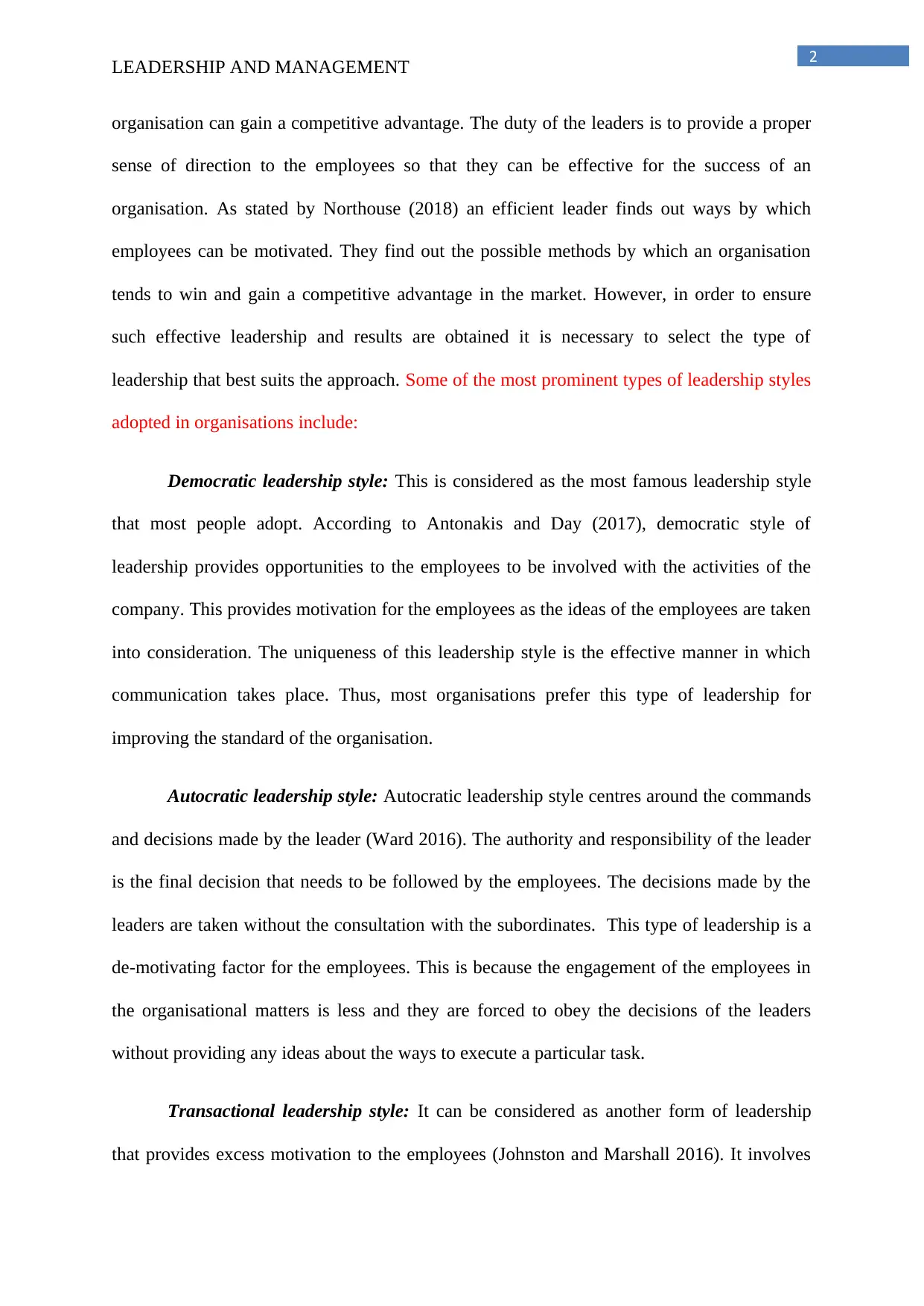
2
LEADERSHIP AND MANAGEMENT
organisation can gain a competitive advantage. The duty of the leaders is to provide a proper
sense of direction to the employees so that they can be effective for the success of an
organisation. As stated by Northouse (2018) an efficient leader finds out ways by which
employees can be motivated. They find out the possible methods by which an organisation
tends to win and gain a competitive advantage in the market. However, in order to ensure
such effective leadership and results are obtained it is necessary to select the type of
leadership that best suits the approach. Some of the most prominent types of leadership styles
adopted in organisations include:
Democratic leadership style: This is considered as the most famous leadership style
that most people adopt. According to Antonakis and Day (2017), democratic style of
leadership provides opportunities to the employees to be involved with the activities of the
company. This provides motivation for the employees as the ideas of the employees are taken
into consideration. The uniqueness of this leadership style is the effective manner in which
communication takes place. Thus, most organisations prefer this type of leadership for
improving the standard of the organisation.
Autocratic leadership style: Autocratic leadership style centres around the commands
and decisions made by the leader (Ward 2016). The authority and responsibility of the leader
is the final decision that needs to be followed by the employees. The decisions made by the
leaders are taken without the consultation with the subordinates. This type of leadership is a
de-motivating factor for the employees. This is because the engagement of the employees in
the organisational matters is less and they are forced to obey the decisions of the leaders
without providing any ideas about the ways to execute a particular task.
Transactional leadership style: It can be considered as another form of leadership
that provides excess motivation to the employees (Johnston and Marshall 2016). It involves
LEADERSHIP AND MANAGEMENT
organisation can gain a competitive advantage. The duty of the leaders is to provide a proper
sense of direction to the employees so that they can be effective for the success of an
organisation. As stated by Northouse (2018) an efficient leader finds out ways by which
employees can be motivated. They find out the possible methods by which an organisation
tends to win and gain a competitive advantage in the market. However, in order to ensure
such effective leadership and results are obtained it is necessary to select the type of
leadership that best suits the approach. Some of the most prominent types of leadership styles
adopted in organisations include:
Democratic leadership style: This is considered as the most famous leadership style
that most people adopt. According to Antonakis and Day (2017), democratic style of
leadership provides opportunities to the employees to be involved with the activities of the
company. This provides motivation for the employees as the ideas of the employees are taken
into consideration. The uniqueness of this leadership style is the effective manner in which
communication takes place. Thus, most organisations prefer this type of leadership for
improving the standard of the organisation.
Autocratic leadership style: Autocratic leadership style centres around the commands
and decisions made by the leader (Ward 2016). The authority and responsibility of the leader
is the final decision that needs to be followed by the employees. The decisions made by the
leaders are taken without the consultation with the subordinates. This type of leadership is a
de-motivating factor for the employees. This is because the engagement of the employees in
the organisational matters is less and they are forced to obey the decisions of the leaders
without providing any ideas about the ways to execute a particular task.
Transactional leadership style: It can be considered as another form of leadership
that provides excess motivation to the employees (Johnston and Marshall 2016). It involves
⊘ This is a preview!⊘
Do you want full access?
Subscribe today to unlock all pages.

Trusted by 1+ million students worldwide
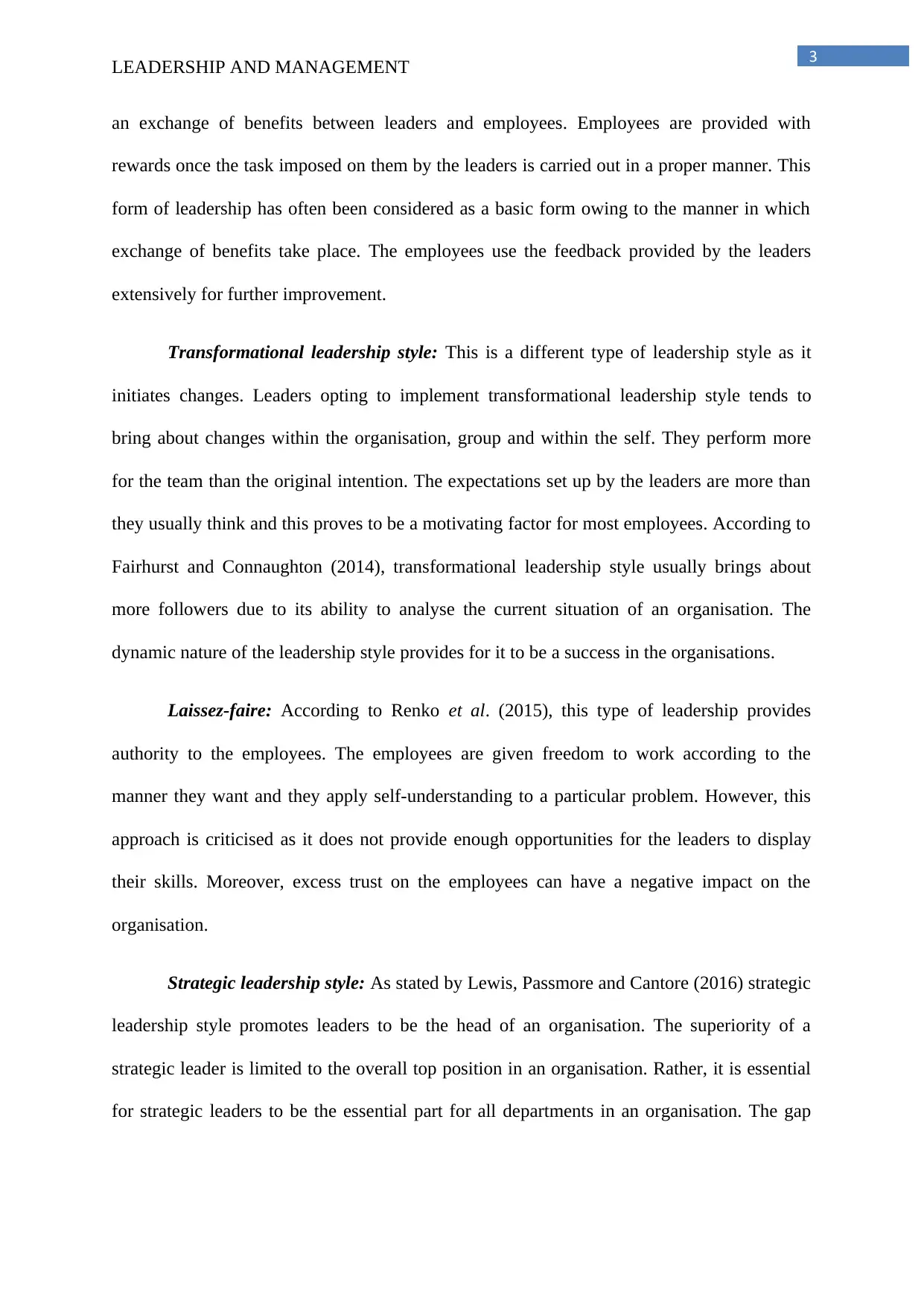
3
LEADERSHIP AND MANAGEMENT
an exchange of benefits between leaders and employees. Employees are provided with
rewards once the task imposed on them by the leaders is carried out in a proper manner. This
form of leadership has often been considered as a basic form owing to the manner in which
exchange of benefits take place. The employees use the feedback provided by the leaders
extensively for further improvement.
Transformational leadership style: This is a different type of leadership style as it
initiates changes. Leaders opting to implement transformational leadership style tends to
bring about changes within the organisation, group and within the self. They perform more
for the team than the original intention. The expectations set up by the leaders are more than
they usually think and this proves to be a motivating factor for most employees. According to
Fairhurst and Connaughton (2014), transformational leadership style usually brings about
more followers due to its ability to analyse the current situation of an organisation. The
dynamic nature of the leadership style provides for it to be a success in the organisations.
Laissez-faire: According to Renko et al. (2015), this type of leadership provides
authority to the employees. The employees are given freedom to work according to the
manner they want and they apply self-understanding to a particular problem. However, this
approach is criticised as it does not provide enough opportunities for the leaders to display
their skills. Moreover, excess trust on the employees can have a negative impact on the
organisation.
Strategic leadership style: As stated by Lewis, Passmore and Cantore (2016) strategic
leadership style promotes leaders to be the head of an organisation. The superiority of a
strategic leader is limited to the overall top position in an organisation. Rather, it is essential
for strategic leaders to be the essential part for all departments in an organisation. The gap
LEADERSHIP AND MANAGEMENT
an exchange of benefits between leaders and employees. Employees are provided with
rewards once the task imposed on them by the leaders is carried out in a proper manner. This
form of leadership has often been considered as a basic form owing to the manner in which
exchange of benefits take place. The employees use the feedback provided by the leaders
extensively for further improvement.
Transformational leadership style: This is a different type of leadership style as it
initiates changes. Leaders opting to implement transformational leadership style tends to
bring about changes within the organisation, group and within the self. They perform more
for the team than the original intention. The expectations set up by the leaders are more than
they usually think and this proves to be a motivating factor for most employees. According to
Fairhurst and Connaughton (2014), transformational leadership style usually brings about
more followers due to its ability to analyse the current situation of an organisation. The
dynamic nature of the leadership style provides for it to be a success in the organisations.
Laissez-faire: According to Renko et al. (2015), this type of leadership provides
authority to the employees. The employees are given freedom to work according to the
manner they want and they apply self-understanding to a particular problem. However, this
approach is criticised as it does not provide enough opportunities for the leaders to display
their skills. Moreover, excess trust on the employees can have a negative impact on the
organisation.
Strategic leadership style: As stated by Lewis, Passmore and Cantore (2016) strategic
leadership style promotes leaders to be the head of an organisation. The superiority of a
strategic leader is limited to the overall top position in an organisation. Rather, it is essential
for strategic leaders to be the essential part for all departments in an organisation. The gap
Paraphrase This Document
Need a fresh take? Get an instant paraphrase of this document with our AI Paraphraser
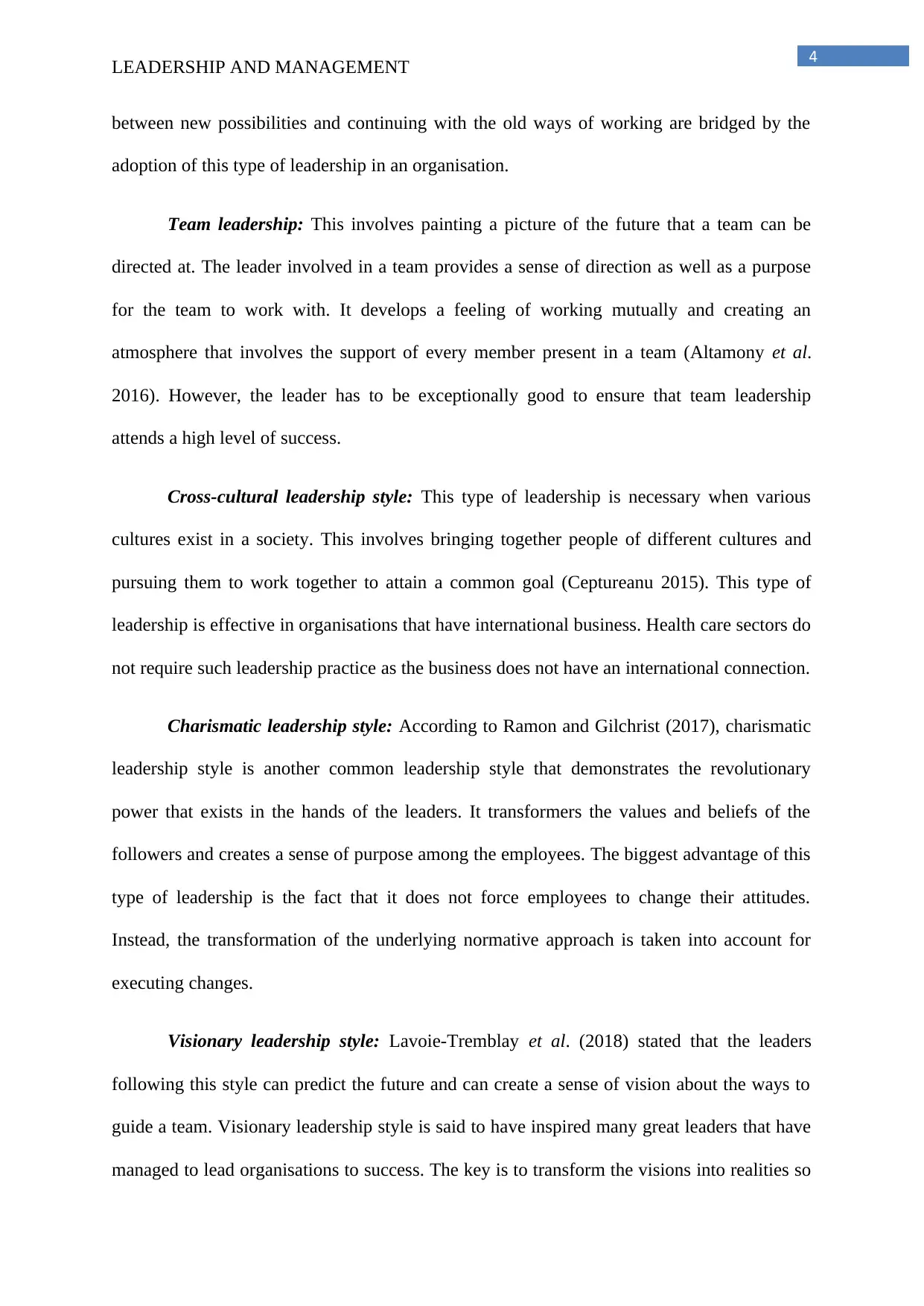
4
LEADERSHIP AND MANAGEMENT
between new possibilities and continuing with the old ways of working are bridged by the
adoption of this type of leadership in an organisation.
Team leadership: This involves painting a picture of the future that a team can be
directed at. The leader involved in a team provides a sense of direction as well as a purpose
for the team to work with. It develops a feeling of working mutually and creating an
atmosphere that involves the support of every member present in a team (Altamony et al.
2016). However, the leader has to be exceptionally good to ensure that team leadership
attends a high level of success.
Cross-cultural leadership style: This type of leadership is necessary when various
cultures exist in a society. This involves bringing together people of different cultures and
pursuing them to work together to attain a common goal (Ceptureanu 2015). This type of
leadership is effective in organisations that have international business. Health care sectors do
not require such leadership practice as the business does not have an international connection.
Charismatic leadership style: According to Ramon and Gilchrist (2017), charismatic
leadership style is another common leadership style that demonstrates the revolutionary
power that exists in the hands of the leaders. It transformers the values and beliefs of the
followers and creates a sense of purpose among the employees. The biggest advantage of this
type of leadership is the fact that it does not force employees to change their attitudes.
Instead, the transformation of the underlying normative approach is taken into account for
executing changes.
Visionary leadership style: Lavoie-Tremblay et al. (2018) stated that the leaders
following this style can predict the future and can create a sense of vision about the ways to
guide a team. Visionary leadership style is said to have inspired many great leaders that have
managed to lead organisations to success. The key is to transform the visions into realities so
LEADERSHIP AND MANAGEMENT
between new possibilities and continuing with the old ways of working are bridged by the
adoption of this type of leadership in an organisation.
Team leadership: This involves painting a picture of the future that a team can be
directed at. The leader involved in a team provides a sense of direction as well as a purpose
for the team to work with. It develops a feeling of working mutually and creating an
atmosphere that involves the support of every member present in a team (Altamony et al.
2016). However, the leader has to be exceptionally good to ensure that team leadership
attends a high level of success.
Cross-cultural leadership style: This type of leadership is necessary when various
cultures exist in a society. This involves bringing together people of different cultures and
pursuing them to work together to attain a common goal (Ceptureanu 2015). This type of
leadership is effective in organisations that have international business. Health care sectors do
not require such leadership practice as the business does not have an international connection.
Charismatic leadership style: According to Ramon and Gilchrist (2017), charismatic
leadership style is another common leadership style that demonstrates the revolutionary
power that exists in the hands of the leaders. It transformers the values and beliefs of the
followers and creates a sense of purpose among the employees. The biggest advantage of this
type of leadership is the fact that it does not force employees to change their attitudes.
Instead, the transformation of the underlying normative approach is taken into account for
executing changes.
Visionary leadership style: Lavoie-Tremblay et al. (2018) stated that the leaders
following this style can predict the future and can create a sense of vision about the ways to
guide a team. Visionary leadership style is said to have inspired many great leaders that have
managed to lead organisations to success. The key is to transform the visions into realities so
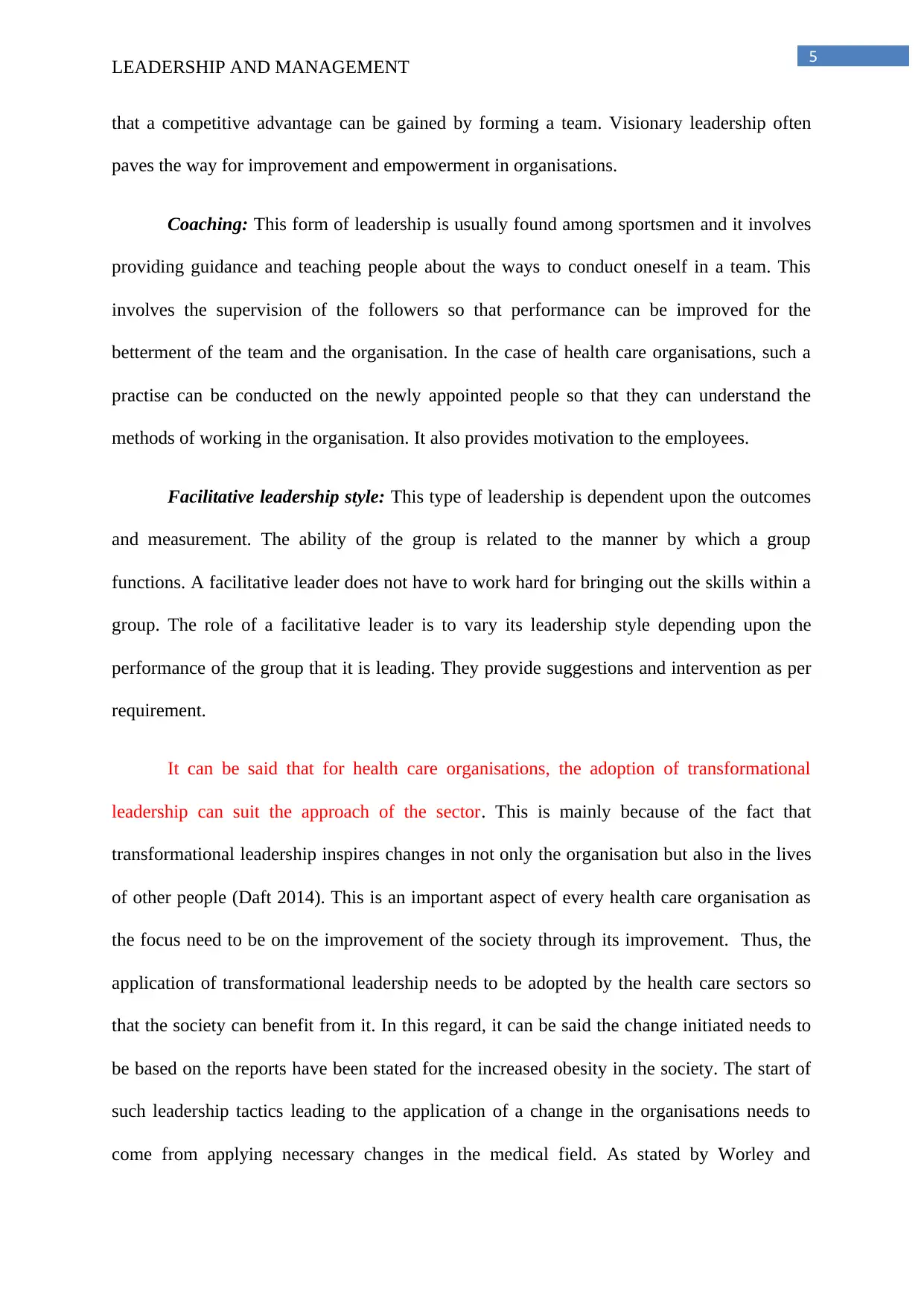
5
LEADERSHIP AND MANAGEMENT
that a competitive advantage can be gained by forming a team. Visionary leadership often
paves the way for improvement and empowerment in organisations.
Coaching: This form of leadership is usually found among sportsmen and it involves
providing guidance and teaching people about the ways to conduct oneself in a team. This
involves the supervision of the followers so that performance can be improved for the
betterment of the team and the organisation. In the case of health care organisations, such a
practise can be conducted on the newly appointed people so that they can understand the
methods of working in the organisation. It also provides motivation to the employees.
Facilitative leadership style: This type of leadership is dependent upon the outcomes
and measurement. The ability of the group is related to the manner by which a group
functions. A facilitative leader does not have to work hard for bringing out the skills within a
group. The role of a facilitative leader is to vary its leadership style depending upon the
performance of the group that it is leading. They provide suggestions and intervention as per
requirement.
It can be said that for health care organisations, the adoption of transformational
leadership can suit the approach of the sector. This is mainly because of the fact that
transformational leadership inspires changes in not only the organisation but also in the lives
of other people (Daft 2014). This is an important aspect of every health care organisation as
the focus need to be on the improvement of the society through its improvement. Thus, the
application of transformational leadership needs to be adopted by the health care sectors so
that the society can benefit from it. In this regard, it can be said the change initiated needs to
be based on the reports have been stated for the increased obesity in the society. The start of
such leadership tactics leading to the application of a change in the organisations needs to
come from applying necessary changes in the medical field. As stated by Worley and
LEADERSHIP AND MANAGEMENT
that a competitive advantage can be gained by forming a team. Visionary leadership often
paves the way for improvement and empowerment in organisations.
Coaching: This form of leadership is usually found among sportsmen and it involves
providing guidance and teaching people about the ways to conduct oneself in a team. This
involves the supervision of the followers so that performance can be improved for the
betterment of the team and the organisation. In the case of health care organisations, such a
practise can be conducted on the newly appointed people so that they can understand the
methods of working in the organisation. It also provides motivation to the employees.
Facilitative leadership style: This type of leadership is dependent upon the outcomes
and measurement. The ability of the group is related to the manner by which a group
functions. A facilitative leader does not have to work hard for bringing out the skills within a
group. The role of a facilitative leader is to vary its leadership style depending upon the
performance of the group that it is leading. They provide suggestions and intervention as per
requirement.
It can be said that for health care organisations, the adoption of transformational
leadership can suit the approach of the sector. This is mainly because of the fact that
transformational leadership inspires changes in not only the organisation but also in the lives
of other people (Daft 2014). This is an important aspect of every health care organisation as
the focus need to be on the improvement of the society through its improvement. Thus, the
application of transformational leadership needs to be adopted by the health care sectors so
that the society can benefit from it. In this regard, it can be said the change initiated needs to
be based on the reports have been stated for the increased obesity in the society. The start of
such leadership tactics leading to the application of a change in the organisations needs to
come from applying necessary changes in the medical field. As stated by Worley and
⊘ This is a preview!⊘
Do you want full access?
Subscribe today to unlock all pages.

Trusted by 1+ million students worldwide
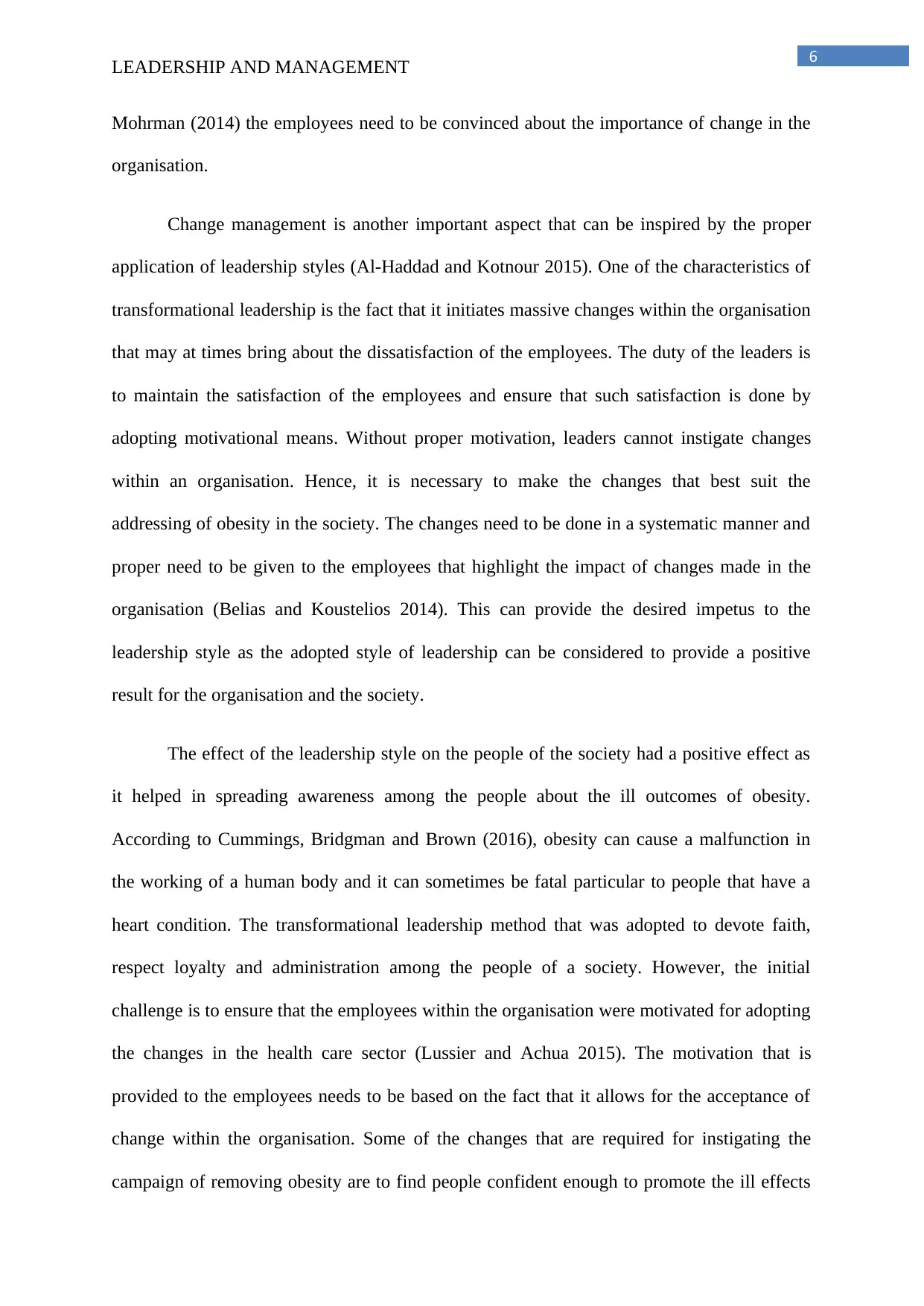
6
LEADERSHIP AND MANAGEMENT
Mohrman (2014) the employees need to be convinced about the importance of change in the
organisation.
Change management is another important aspect that can be inspired by the proper
application of leadership styles (Al-Haddad and Kotnour 2015). One of the characteristics of
transformational leadership is the fact that it initiates massive changes within the organisation
that may at times bring about the dissatisfaction of the employees. The duty of the leaders is
to maintain the satisfaction of the employees and ensure that such satisfaction is done by
adopting motivational means. Without proper motivation, leaders cannot instigate changes
within an organisation. Hence, it is necessary to make the changes that best suit the
addressing of obesity in the society. The changes need to be done in a systematic manner and
proper need to be given to the employees that highlight the impact of changes made in the
organisation (Belias and Koustelios 2014). This can provide the desired impetus to the
leadership style as the adopted style of leadership can be considered to provide a positive
result for the organisation and the society.
The effect of the leadership style on the people of the society had a positive effect as
it helped in spreading awareness among the people about the ill outcomes of obesity.
According to Cummings, Bridgman and Brown (2016), obesity can cause a malfunction in
the working of a human body and it can sometimes be fatal particular to people that have a
heart condition. The transformational leadership method that was adopted to devote faith,
respect loyalty and administration among the people of a society. However, the initial
challenge is to ensure that the employees within the organisation were motivated for adopting
the changes in the health care sector (Lussier and Achua 2015). The motivation that is
provided to the employees needs to be based on the fact that it allows for the acceptance of
change within the organisation. Some of the changes that are required for instigating the
campaign of removing obesity are to find people confident enough to promote the ill effects
LEADERSHIP AND MANAGEMENT
Mohrman (2014) the employees need to be convinced about the importance of change in the
organisation.
Change management is another important aspect that can be inspired by the proper
application of leadership styles (Al-Haddad and Kotnour 2015). One of the characteristics of
transformational leadership is the fact that it initiates massive changes within the organisation
that may at times bring about the dissatisfaction of the employees. The duty of the leaders is
to maintain the satisfaction of the employees and ensure that such satisfaction is done by
adopting motivational means. Without proper motivation, leaders cannot instigate changes
within an organisation. Hence, it is necessary to make the changes that best suit the
addressing of obesity in the society. The changes need to be done in a systematic manner and
proper need to be given to the employees that highlight the impact of changes made in the
organisation (Belias and Koustelios 2014). This can provide the desired impetus to the
leadership style as the adopted style of leadership can be considered to provide a positive
result for the organisation and the society.
The effect of the leadership style on the people of the society had a positive effect as
it helped in spreading awareness among the people about the ill outcomes of obesity.
According to Cummings, Bridgman and Brown (2016), obesity can cause a malfunction in
the working of a human body and it can sometimes be fatal particular to people that have a
heart condition. The transformational leadership method that was adopted to devote faith,
respect loyalty and administration among the people of a society. However, the initial
challenge is to ensure that the employees within the organisation were motivated for adopting
the changes in the health care sector (Lussier and Achua 2015). The motivation that is
provided to the employees needs to be based on the fact that it allows for the acceptance of
change within the organisation. Some of the changes that are required for instigating the
campaign of removing obesity are to find people confident enough to promote the ill effects
Paraphrase This Document
Need a fresh take? Get an instant paraphrase of this document with our AI Paraphraser
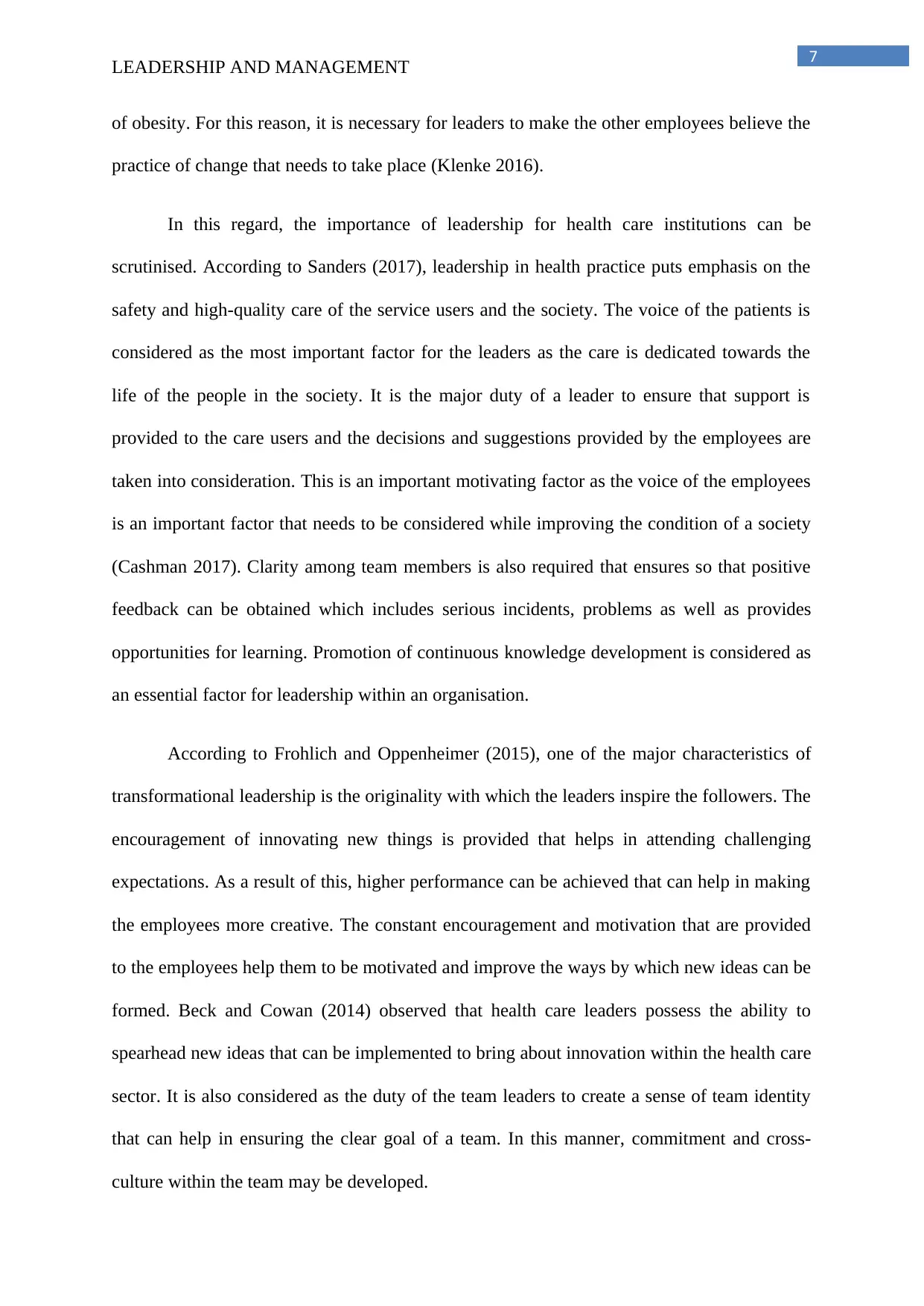
7
LEADERSHIP AND MANAGEMENT
of obesity. For this reason, it is necessary for leaders to make the other employees believe the
practice of change that needs to take place (Klenke 2016).
In this regard, the importance of leadership for health care institutions can be
scrutinised. According to Sanders (2017), leadership in health practice puts emphasis on the
safety and high-quality care of the service users and the society. The voice of the patients is
considered as the most important factor for the leaders as the care is dedicated towards the
life of the people in the society. It is the major duty of a leader to ensure that support is
provided to the care users and the decisions and suggestions provided by the employees are
taken into consideration. This is an important motivating factor as the voice of the employees
is an important factor that needs to be considered while improving the condition of a society
(Cashman 2017). Clarity among team members is also required that ensures so that positive
feedback can be obtained which includes serious incidents, problems as well as provides
opportunities for learning. Promotion of continuous knowledge development is considered as
an essential factor for leadership within an organisation.
According to Frohlich and Oppenheimer (2015), one of the major characteristics of
transformational leadership is the originality with which the leaders inspire the followers. The
encouragement of innovating new things is provided that helps in attending challenging
expectations. As a result of this, higher performance can be achieved that can help in making
the employees more creative. The constant encouragement and motivation that are provided
to the employees help them to be motivated and improve the ways by which new ideas can be
formed. Beck and Cowan (2014) observed that health care leaders possess the ability to
spearhead new ideas that can be implemented to bring about innovation within the health care
sector. It is also considered as the duty of the team leaders to create a sense of team identity
that can help in ensuring the clear goal of a team. In this manner, commitment and cross-
culture within the team may be developed.
LEADERSHIP AND MANAGEMENT
of obesity. For this reason, it is necessary for leaders to make the other employees believe the
practice of change that needs to take place (Klenke 2016).
In this regard, the importance of leadership for health care institutions can be
scrutinised. According to Sanders (2017), leadership in health practice puts emphasis on the
safety and high-quality care of the service users and the society. The voice of the patients is
considered as the most important factor for the leaders as the care is dedicated towards the
life of the people in the society. It is the major duty of a leader to ensure that support is
provided to the care users and the decisions and suggestions provided by the employees are
taken into consideration. This is an important motivating factor as the voice of the employees
is an important factor that needs to be considered while improving the condition of a society
(Cashman 2017). Clarity among team members is also required that ensures so that positive
feedback can be obtained which includes serious incidents, problems as well as provides
opportunities for learning. Promotion of continuous knowledge development is considered as
an essential factor for leadership within an organisation.
According to Frohlich and Oppenheimer (2015), one of the major characteristics of
transformational leadership is the originality with which the leaders inspire the followers. The
encouragement of innovating new things is provided that helps in attending challenging
expectations. As a result of this, higher performance can be achieved that can help in making
the employees more creative. The constant encouragement and motivation that are provided
to the employees help them to be motivated and improve the ways by which new ideas can be
formed. Beck and Cowan (2014) observed that health care leaders possess the ability to
spearhead new ideas that can be implemented to bring about innovation within the health care
sector. It is also considered as the duty of the team leaders to create a sense of team identity
that can help in ensuring the clear goal of a team. In this manner, commitment and cross-
culture within the team may be developed.
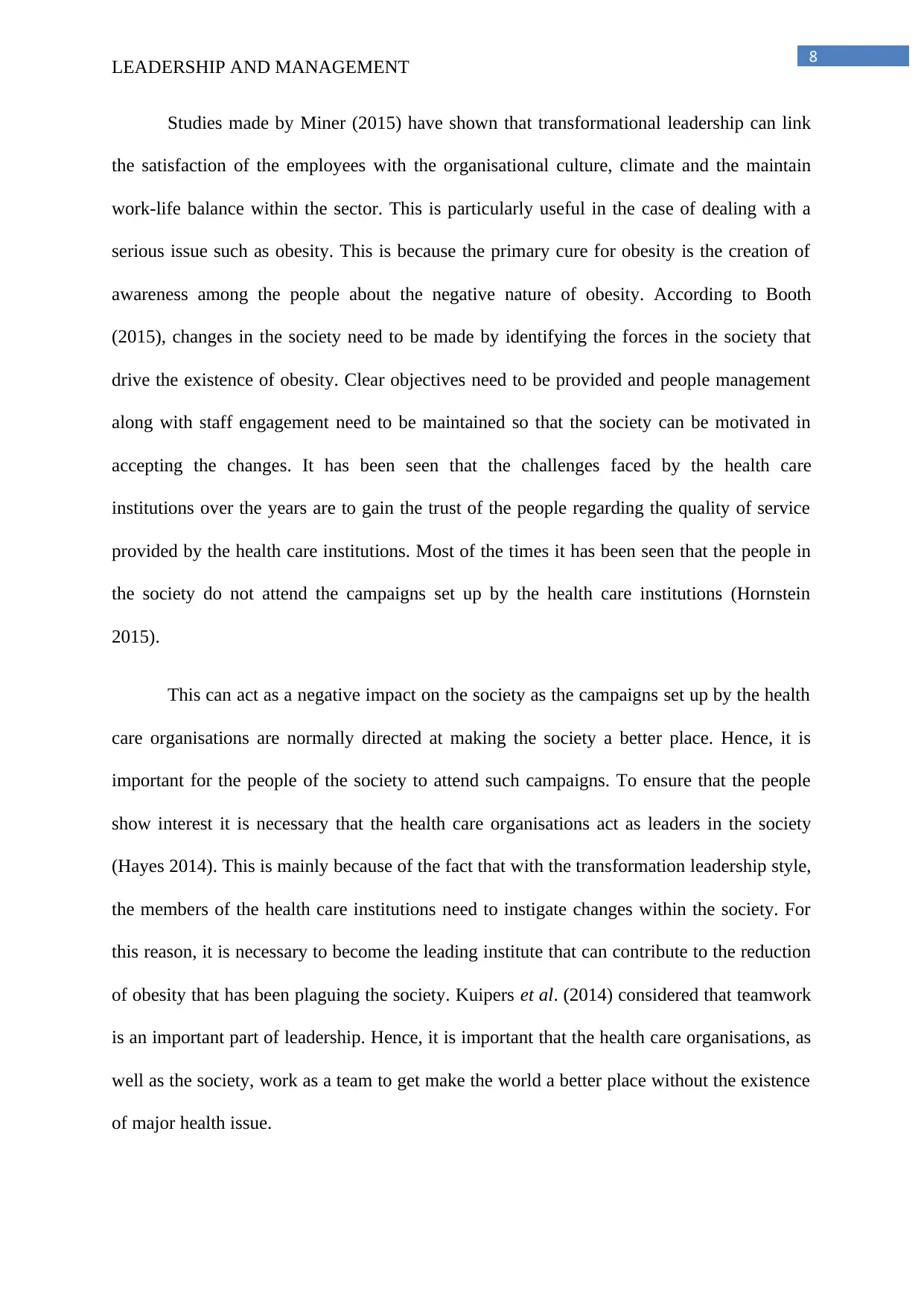
8
LEADERSHIP AND MANAGEMENT
Studies made by Miner (2015) have shown that transformational leadership can link
the satisfaction of the employees with the organisational culture, climate and the maintain
work-life balance within the sector. This is particularly useful in the case of dealing with a
serious issue such as obesity. This is because the primary cure for obesity is the creation of
awareness among the people about the negative nature of obesity. According to Booth
(2015), changes in the society need to be made by identifying the forces in the society that
drive the existence of obesity. Clear objectives need to be provided and people management
along with staff engagement need to be maintained so that the society can be motivated in
accepting the changes. It has been seen that the challenges faced by the health care
institutions over the years are to gain the trust of the people regarding the quality of service
provided by the health care institutions. Most of the times it has been seen that the people in
the society do not attend the campaigns set up by the health care institutions (Hornstein
2015).
This can act as a negative impact on the society as the campaigns set up by the health
care organisations are normally directed at making the society a better place. Hence, it is
important for the people of the society to attend such campaigns. To ensure that the people
show interest it is necessary that the health care organisations act as leaders in the society
(Hayes 2014). This is mainly because of the fact that with the transformation leadership style,
the members of the health care institutions need to instigate changes within the society. For
this reason, it is necessary to become the leading institute that can contribute to the reduction
of obesity that has been plaguing the society. Kuipers et al. (2014) considered that teamwork
is an important part of leadership. Hence, it is important that the health care organisations, as
well as the society, work as a team to get make the world a better place without the existence
of major health issue.
LEADERSHIP AND MANAGEMENT
Studies made by Miner (2015) have shown that transformational leadership can link
the satisfaction of the employees with the organisational culture, climate and the maintain
work-life balance within the sector. This is particularly useful in the case of dealing with a
serious issue such as obesity. This is because the primary cure for obesity is the creation of
awareness among the people about the negative nature of obesity. According to Booth
(2015), changes in the society need to be made by identifying the forces in the society that
drive the existence of obesity. Clear objectives need to be provided and people management
along with staff engagement need to be maintained so that the society can be motivated in
accepting the changes. It has been seen that the challenges faced by the health care
institutions over the years are to gain the trust of the people regarding the quality of service
provided by the health care institutions. Most of the times it has been seen that the people in
the society do not attend the campaigns set up by the health care institutions (Hornstein
2015).
This can act as a negative impact on the society as the campaigns set up by the health
care organisations are normally directed at making the society a better place. Hence, it is
important for the people of the society to attend such campaigns. To ensure that the people
show interest it is necessary that the health care organisations act as leaders in the society
(Hayes 2014). This is mainly because of the fact that with the transformation leadership style,
the members of the health care institutions need to instigate changes within the society. For
this reason, it is necessary to become the leading institute that can contribute to the reduction
of obesity that has been plaguing the society. Kuipers et al. (2014) considered that teamwork
is an important part of leadership. Hence, it is important that the health care organisations, as
well as the society, work as a team to get make the world a better place without the existence
of major health issue.
⊘ This is a preview!⊘
Do you want full access?
Subscribe today to unlock all pages.

Trusted by 1+ million students worldwide
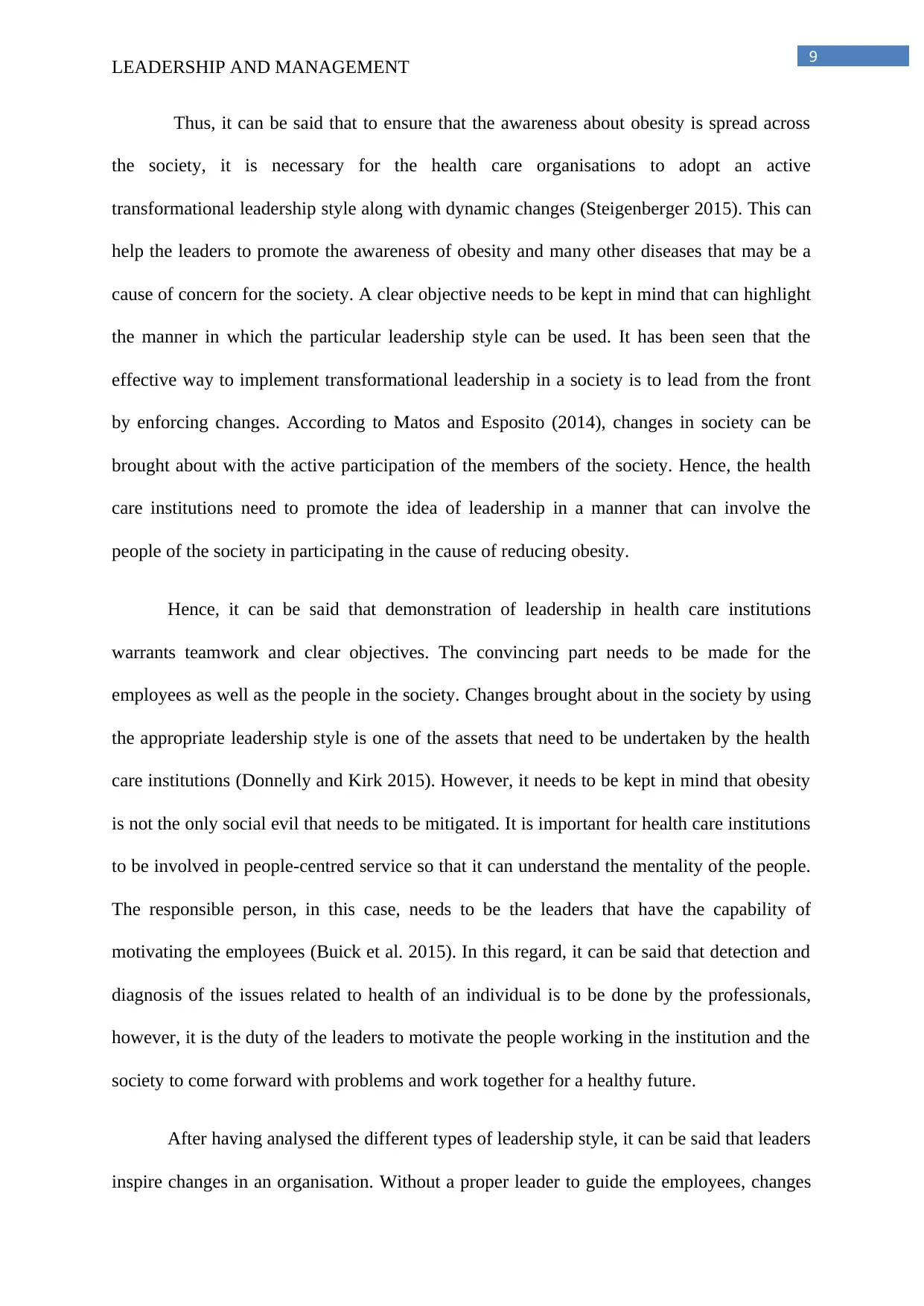
9
LEADERSHIP AND MANAGEMENT
Thus, it can be said that to ensure that the awareness about obesity is spread across
the society, it is necessary for the health care organisations to adopt an active
transformational leadership style along with dynamic changes (Steigenberger 2015). This can
help the leaders to promote the awareness of obesity and many other diseases that may be a
cause of concern for the society. A clear objective needs to be kept in mind that can highlight
the manner in which the particular leadership style can be used. It has been seen that the
effective way to implement transformational leadership in a society is to lead from the front
by enforcing changes. According to Matos and Esposito (2014), changes in society can be
brought about with the active participation of the members of the society. Hence, the health
care institutions need to promote the idea of leadership in a manner that can involve the
people of the society in participating in the cause of reducing obesity.
Hence, it can be said that demonstration of leadership in health care institutions
warrants teamwork and clear objectives. The convincing part needs to be made for the
employees as well as the people in the society. Changes brought about in the society by using
the appropriate leadership style is one of the assets that need to be undertaken by the health
care institutions (Donnelly and Kirk 2015). However, it needs to be kept in mind that obesity
is not the only social evil that needs to be mitigated. It is important for health care institutions
to be involved in people-centred service so that it can understand the mentality of the people.
The responsible person, in this case, needs to be the leaders that have the capability of
motivating the employees (Buick et al. 2015). In this regard, it can be said that detection and
diagnosis of the issues related to health of an individual is to be done by the professionals,
however, it is the duty of the leaders to motivate the people working in the institution and the
society to come forward with problems and work together for a healthy future.
After having analysed the different types of leadership style, it can be said that leaders
inspire changes in an organisation. Without a proper leader to guide the employees, changes
LEADERSHIP AND MANAGEMENT
Thus, it can be said that to ensure that the awareness about obesity is spread across
the society, it is necessary for the health care organisations to adopt an active
transformational leadership style along with dynamic changes (Steigenberger 2015). This can
help the leaders to promote the awareness of obesity and many other diseases that may be a
cause of concern for the society. A clear objective needs to be kept in mind that can highlight
the manner in which the particular leadership style can be used. It has been seen that the
effective way to implement transformational leadership in a society is to lead from the front
by enforcing changes. According to Matos and Esposito (2014), changes in society can be
brought about with the active participation of the members of the society. Hence, the health
care institutions need to promote the idea of leadership in a manner that can involve the
people of the society in participating in the cause of reducing obesity.
Hence, it can be said that demonstration of leadership in health care institutions
warrants teamwork and clear objectives. The convincing part needs to be made for the
employees as well as the people in the society. Changes brought about in the society by using
the appropriate leadership style is one of the assets that need to be undertaken by the health
care institutions (Donnelly and Kirk 2015). However, it needs to be kept in mind that obesity
is not the only social evil that needs to be mitigated. It is important for health care institutions
to be involved in people-centred service so that it can understand the mentality of the people.
The responsible person, in this case, needs to be the leaders that have the capability of
motivating the employees (Buick et al. 2015). In this regard, it can be said that detection and
diagnosis of the issues related to health of an individual is to be done by the professionals,
however, it is the duty of the leaders to motivate the people working in the institution and the
society to come forward with problems and work together for a healthy future.
After having analysed the different types of leadership style, it can be said that leaders
inspire changes in an organisation. Without a proper leader to guide the employees, changes
Paraphrase This Document
Need a fresh take? Get an instant paraphrase of this document with our AI Paraphraser
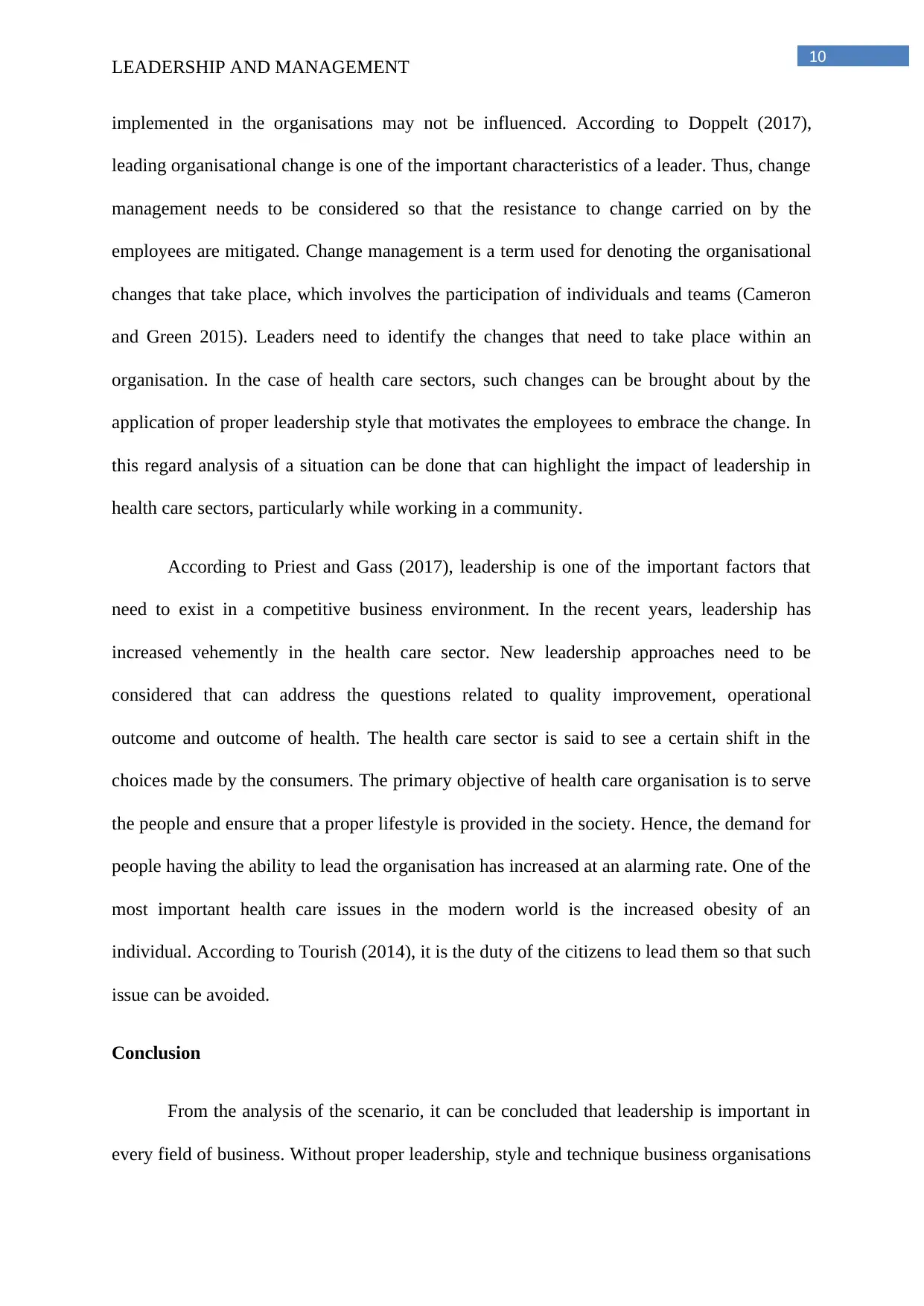
10
LEADERSHIP AND MANAGEMENT
implemented in the organisations may not be influenced. According to Doppelt (2017),
leading organisational change is one of the important characteristics of a leader. Thus, change
management needs to be considered so that the resistance to change carried on by the
employees are mitigated. Change management is a term used for denoting the organisational
changes that take place, which involves the participation of individuals and teams (Cameron
and Green 2015). Leaders need to identify the changes that need to take place within an
organisation. In the case of health care sectors, such changes can be brought about by the
application of proper leadership style that motivates the employees to embrace the change. In
this regard analysis of a situation can be done that can highlight the impact of leadership in
health care sectors, particularly while working in a community.
According to Priest and Gass (2017), leadership is one of the important factors that
need to exist in a competitive business environment. In the recent years, leadership has
increased vehemently in the health care sector. New leadership approaches need to be
considered that can address the questions related to quality improvement, operational
outcome and outcome of health. The health care sector is said to see a certain shift in the
choices made by the consumers. The primary objective of health care organisation is to serve
the people and ensure that a proper lifestyle is provided in the society. Hence, the demand for
people having the ability to lead the organisation has increased at an alarming rate. One of the
most important health care issues in the modern world is the increased obesity of an
individual. According to Tourish (2014), it is the duty of the citizens to lead them so that such
issue can be avoided.
Conclusion
From the analysis of the scenario, it can be concluded that leadership is important in
every field of business. Without proper leadership, style and technique business organisations
LEADERSHIP AND MANAGEMENT
implemented in the organisations may not be influenced. According to Doppelt (2017),
leading organisational change is one of the important characteristics of a leader. Thus, change
management needs to be considered so that the resistance to change carried on by the
employees are mitigated. Change management is a term used for denoting the organisational
changes that take place, which involves the participation of individuals and teams (Cameron
and Green 2015). Leaders need to identify the changes that need to take place within an
organisation. In the case of health care sectors, such changes can be brought about by the
application of proper leadership style that motivates the employees to embrace the change. In
this regard analysis of a situation can be done that can highlight the impact of leadership in
health care sectors, particularly while working in a community.
According to Priest and Gass (2017), leadership is one of the important factors that
need to exist in a competitive business environment. In the recent years, leadership has
increased vehemently in the health care sector. New leadership approaches need to be
considered that can address the questions related to quality improvement, operational
outcome and outcome of health. The health care sector is said to see a certain shift in the
choices made by the consumers. The primary objective of health care organisation is to serve
the people and ensure that a proper lifestyle is provided in the society. Hence, the demand for
people having the ability to lead the organisation has increased at an alarming rate. One of the
most important health care issues in the modern world is the increased obesity of an
individual. According to Tourish (2014), it is the duty of the citizens to lead them so that such
issue can be avoided.
Conclusion
From the analysis of the scenario, it can be concluded that leadership is important in
every field of business. Without proper leadership, style and technique business organisations
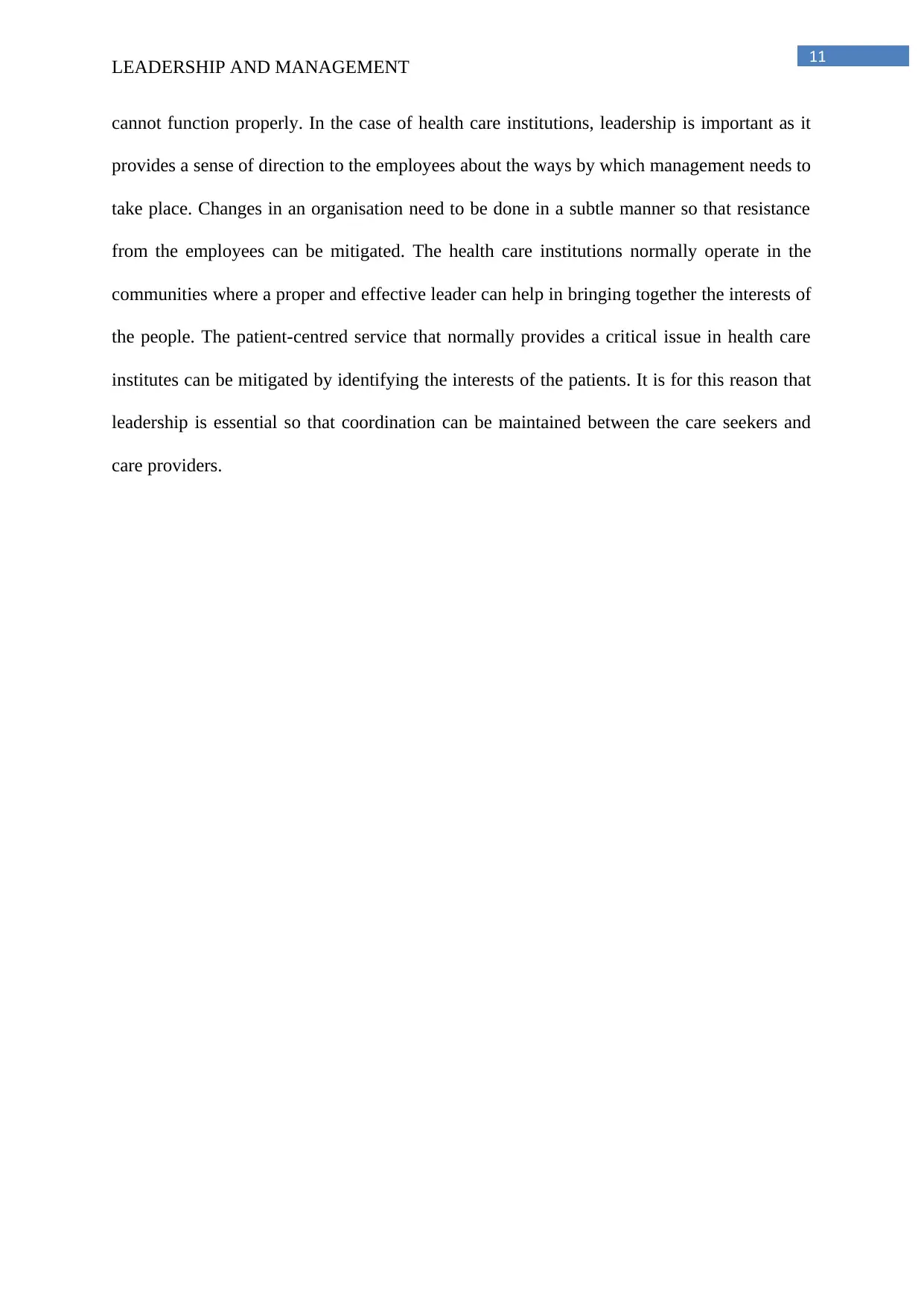
11
LEADERSHIP AND MANAGEMENT
cannot function properly. In the case of health care institutions, leadership is important as it
provides a sense of direction to the employees about the ways by which management needs to
take place. Changes in an organisation need to be done in a subtle manner so that resistance
from the employees can be mitigated. The health care institutions normally operate in the
communities where a proper and effective leader can help in bringing together the interests of
the people. The patient-centred service that normally provides a critical issue in health care
institutes can be mitigated by identifying the interests of the patients. It is for this reason that
leadership is essential so that coordination can be maintained between the care seekers and
care providers.
LEADERSHIP AND MANAGEMENT
cannot function properly. In the case of health care institutions, leadership is important as it
provides a sense of direction to the employees about the ways by which management needs to
take place. Changes in an organisation need to be done in a subtle manner so that resistance
from the employees can be mitigated. The health care institutions normally operate in the
communities where a proper and effective leader can help in bringing together the interests of
the people. The patient-centred service that normally provides a critical issue in health care
institutes can be mitigated by identifying the interests of the patients. It is for this reason that
leadership is essential so that coordination can be maintained between the care seekers and
care providers.
⊘ This is a preview!⊘
Do you want full access?
Subscribe today to unlock all pages.

Trusted by 1+ million students worldwide
1 out of 16
Related Documents
Your All-in-One AI-Powered Toolkit for Academic Success.
+13062052269
info@desklib.com
Available 24*7 on WhatsApp / Email
![[object Object]](/_next/static/media/star-bottom.7253800d.svg)
Unlock your academic potential
Copyright © 2020–2025 A2Z Services. All Rights Reserved. Developed and managed by ZUCOL.





